2005 Hyundai Terracan cooling
[x] Cancel search: coolingPage 475 of 539
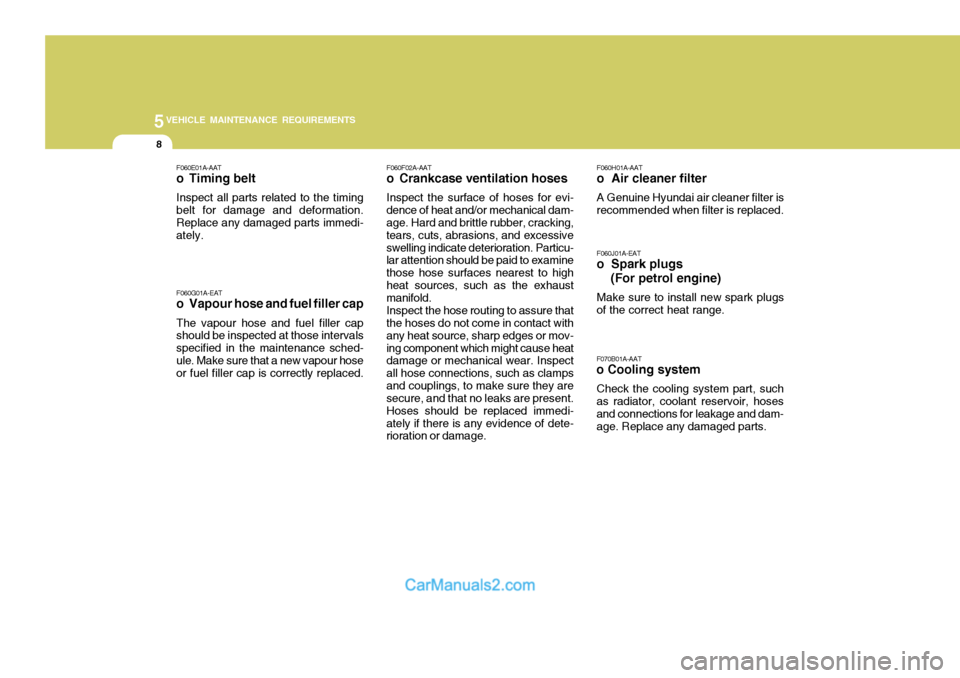
5VEHICLE MAINTENANCE REQUIREMENTS
8
F060E01A-AAT
o Timing belt Inspect all parts related to the timing belt for damage and deformation. Replace any damaged parts immedi- ately. F060G01A-EAT
o Vapour hose and fuel filler cap The vapour hose and fuel filler cap should be inspected at those intervals specified in the maintenance sched-ule. Make sure that a new vapour hose or fuel filler cap is correctly replaced. F060F02A-AAT
o Crankcase ventilation hoses
Inspect the surface of hoses for evi-
dence of heat and/or mechanical dam-age. Hard and brittle rubber, cracking, tears, cuts, abrasions, and excessiveswelling indicate deterioration. Particu- lar attention should be paid to examine those hose surfaces nearest to highheat sources, such as the exhaust manifold.
Inspect the hose routing to assure that
the hoses do not come in contact with any heat source, sharp edges or mov-ing component which might cause heat damage or mechanical wear. Inspect all hose connections, such as clampsand couplings, to make sure they are secure, and that no leaks are present. Hoses should be replaced immedi-ately if there is any evidence of dete- rioration or damage. F060H01A-AAT
o Air cleaner filter
A Genuine Hyundai air cleaner filter is
recommended when filter is replaced.
F060J01A-EAT
o Spark plugs (For petrol engine)
Make sure to install new spark plugs
of the correct heat range. F070B01A-AAT
o Cooling system
Check the cooling system part, such as radiator, coolant reservoir, hosesand connections for leakage and dam- age. Replace any damaged parts.
Page 478 of 539
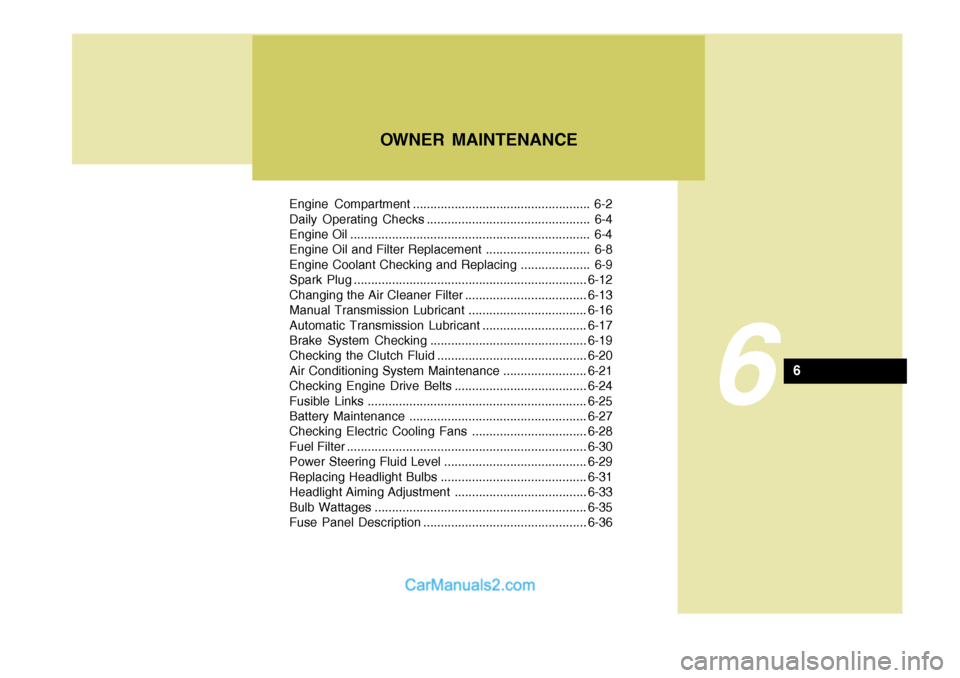
Engine Compartment ................................................... 6-2
Daily Operating Checks ............................................... 6-4
Engine Oil ..................................................................... 6-4
Engine Oil and Filter Replacement .............................. 6-8
Engine Coolant Checking and Replacing .................... 6-9Spark Plug................................................................... 6-12
Changing the Air Cleaner Filte r ...................................6-13
Manual Transmission Lubricant ..................................6-16
Automatic Transmission Lubricant ..............................6-17
Brake System Checking ............................................. 6-19
Checking the Clutch Fluid ........................................... 6-20
Air Conditioning System Maintenance ........................ 6-21
Checking Engine Drive Belts ...................................... 6-24
Fusible Links ............................................................... 6-25
Battery Mai ntenance ................................................... 6-27
Checking Electric Cooling Fans .................................6-28
Fuel Filter ..................................................................... 6-30
Power Steering Fluid Level ......................................... 6-29
Replacing Headlight Bulbs .......................................... 6-31
Headlight Aiming Adjustment ...................................... 6-33
Bulb Wattages ............................................................. 6-35
Fuse Panel D escription ............................................... 6-36
OWNER MAINTENANCE
6
6
Page 484 of 539
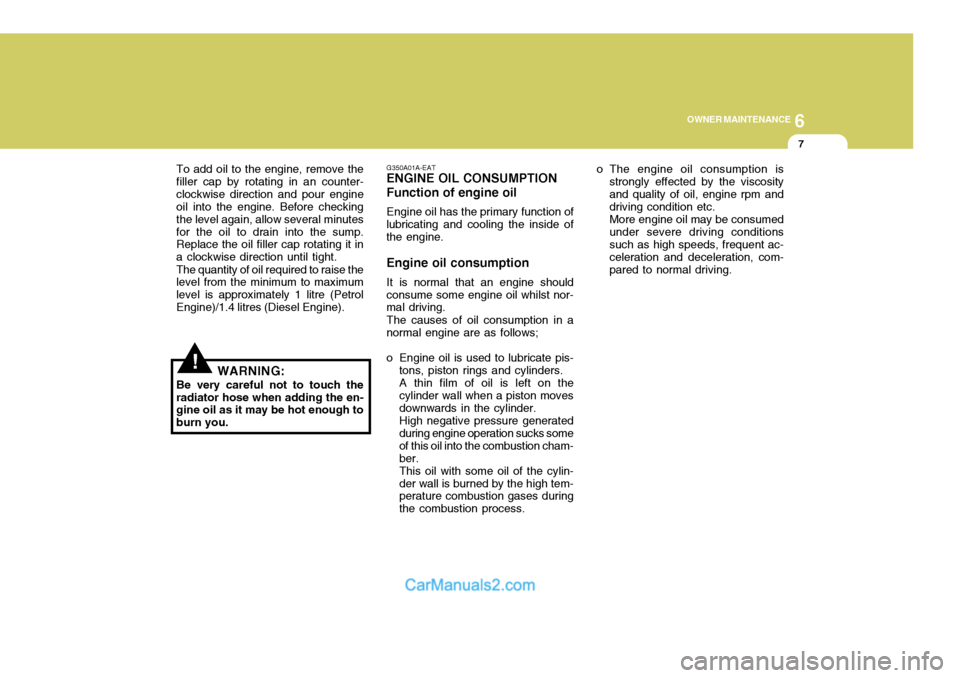
6
OWNER MAINTENANCE
7
G350A01A-EAT
ENGINE OIL CONSUMPTION Function of engine oil
Engine oil has the primary function of
lubricating and cooling the inside of the engine. Engine oil consumption
It is normal that an engine should
consume some engine oil whilst nor- mal driving.
The causes of oil consumption in a
normal engine are as follows;
o Engine oil is used to lubricate pis- tons, piston rings and cylinders. A thin film of oil is left on the cylinder wall when a piston moves downwards in the cylinder. High negative pressure generated during engine operation sucks some of this oil into the combustion cham-ber.This oil with some oil of the cylin-der wall is burned by the high tem- perature combustion gases during the combustion process. o The engine oil consumption is
strongly effected by the viscosityand quality of oil, engine rpm and driving condition etc. More engine oil may be consumed under severe driving conditions such as high speeds, frequent ac- celeration and deceleration, com-pared to normal driving.
!
To add oil to the engine, remove the filler cap by rotating in an counter-clockwise direction and pour engine oil into the engine. Before checking the level again, allow several minutesfor the oil to drain into the sump. Replace the oil filler cap rotating it in a clockwise direction until tight. The quantity of oil required to raise the level from the minimum to maximum level is approximately 1 litre (PetrolEngine)/1.4 litres (Diesel Engine).
WARNING:
Be very careful not to touch theradiator hose when adding the en- gine oil as it may be hot enough to burn you.
Page 486 of 539
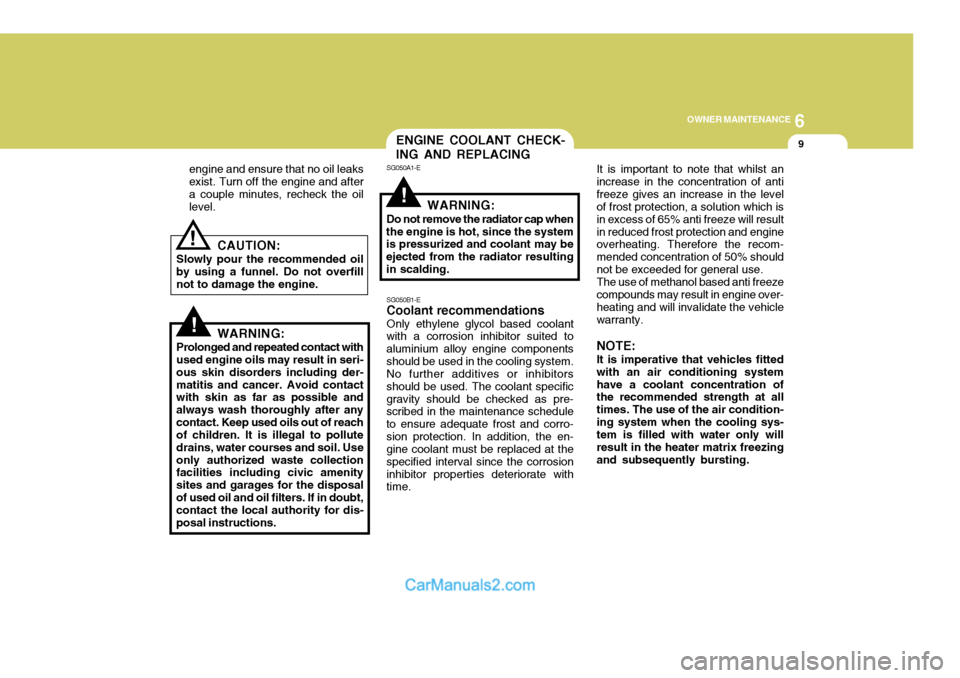
6
OWNER MAINTENANCE
9
!
!
engine and ensure that no oil leaks exist. Turn off the engine and aftera couple minutes, recheck the oil level.
CAUTION:
Slowly pour the recommended oil by using a funnel. Do not overfill not to damage the engine.
WARNING:
Prolonged and repeated contact withused engine oils may result in seri- ous skin disorders including der-matitis and cancer. Avoid contact with skin as far as possible and always wash thoroughly after anycontact. Keep used oils out of reach of children. It is illegal to pollute drains, water courses and soil. Useonly authorized waste collection facilities including civic amenity sites and garages for the disposalof used oil and oil filters. If in doubt, contact the local authority for dis- posal instructions. WARNING:
Do not remove the radiator cap when
the engine is hot, since the system is pressurized and coolant may be ejected from the radiator resultingin scalding.
SG050B1-E
Coolant recommendations
Only ethylene glycol based coolant
with a corrosion inhibitor suited toaluminium alloy engine componentsshould be used in the cooling system. No further additives or inhibitors should be used. The coolant specificgravity should be checked as pre- scribed in the maintenance schedule to ensure adequate frost and corro-sion protection. In addition, the en- gine coolant must be replaced at the specified interval since the corrosioninhibitor properties deteriorate with time.
ENGINE COOLANT CHECK- ING AND REPLACING
SG050A1-E
! It is important to note that whilst an increase in the concentration of antifreeze gives an increase in the level of frost protection, a solution which is in excess of 65% anti freeze will resultin reduced frost protection and engine overheating. Therefore the recom- mended concentration of 50% shouldnot be exceeded for general use.The use of methanol based anti freezecompounds may result in engine over-heating and will invalidate the vehicle warranty. NOTE: It is imperative that vehicles fitted with an air conditioning systemhave a coolant concentration of the recommended strength at all times. The use of the air condition-ing system when the cooling sys- tem is filled with water only will result in the heater matrix freezingand subsequently bursting.
Page 488 of 539
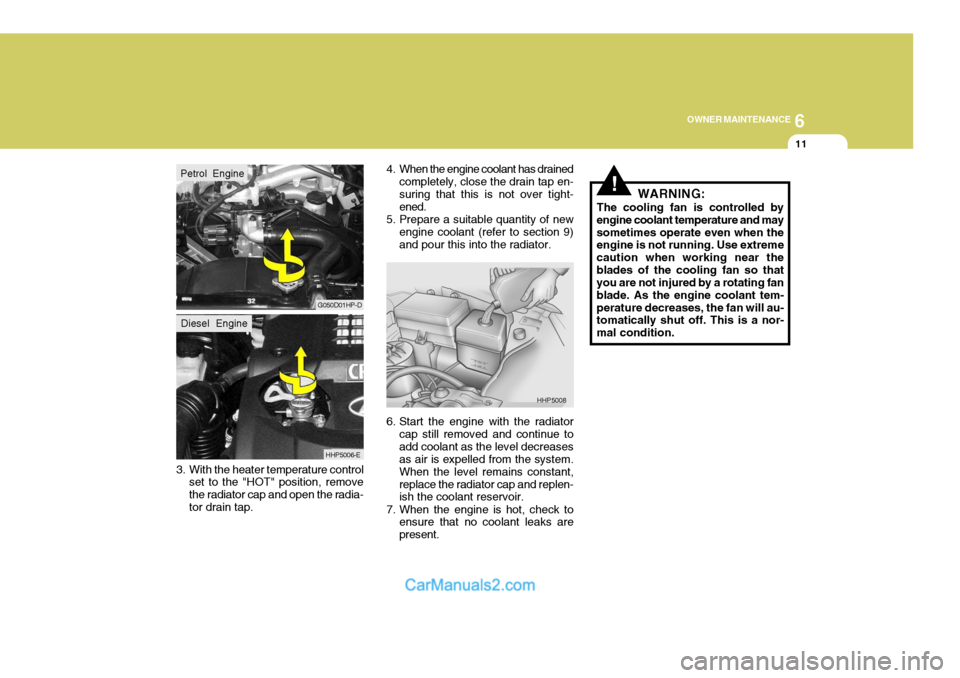
6
OWNER MAINTENANCE
11
3. With the heater temperature control set to the "HOT" position, remove the radiator cap and open the radia-tor drain tap. 4. When the engine coolant has drained
completely, close the drain tap en-suring that this is not over tight- ened.
5. Prepare a suitable quantity of new engine coolant (refer to section 9)and pour this into the radiator.
6. Start the engine with the radiator cap still removed and continue to add coolant as the level decreases as air is expelled from the system. When the level remains constant,replace the radiator cap and replen- ish the coolant reservoir.
7. When the engine is hot, check to ensure that no coolant leaks are present.
G050D01HP-D
HHP5006-E
HHP5008
Petrol EngineDiesel Engine
!WARNING:
The cooling fan is controlled by engine coolant temperature and maysometimes operate even when the engine is not running. Use extreme caution when working near theblades of the cooling fan so that you are not injured by a rotating fan blade. As the engine coolant tem-perature decreases, the fan will au- tomatically shut off. This is a nor- mal condition.
Page 496 of 539

6
OWNER MAINTENANCE
19
!
!
!
3. If the transmission fluid level is low,
use a funnel to add transmission fluid through the dipstick tube until the level reaches the "HOT" range. Do not overfill. WARNING (Diesel only):
Never work on injection system with
engine running or within 30 sec-onds after shutting off engine. Highpressure pump, rail, injectors and high pressure pipes are subject to high pressure even after the enginestopped. The fuel jet produced by fuel leaks may cause serious injury, if it touch the body. People usingpacemakers should not move than 30cm closer to the ECU or wiring harness within the engine roomwhilst engine is running, since the high currents in the Common Rail system produce considerable mag-netic fields.
WARNING:
The electric engine cooling fan au-tomatically switches on and off ac- cording to engine temperature. Be careful to keep away from the fanduring this check as it may switch on at any time. NOTE: Only lint free cloth should be used
for wiping the dipstick. The pres- ence of lint within the transmis- sion may cause problems with the normal function of the transmis-sion. CAUTION:
Correct operation of the brakingsystem is essential to the safe op- eration of the vehicle and there- fore, any maintenance operationsother than those listed below should be entrusted to a Hyundai dealer. SG120C2-E Brake Fluid Recommendations Only brake fluid conforming to DOT 3 or DOT 4 specifications or highermay be used in the braking system. Care should be taken to observe the instructions and precautions printedupon the container.
Fluid level should be within "HOT" range
G110D04HP
BRAKE SYSTEM CHECKING
SG120A1-E
Page 505 of 539
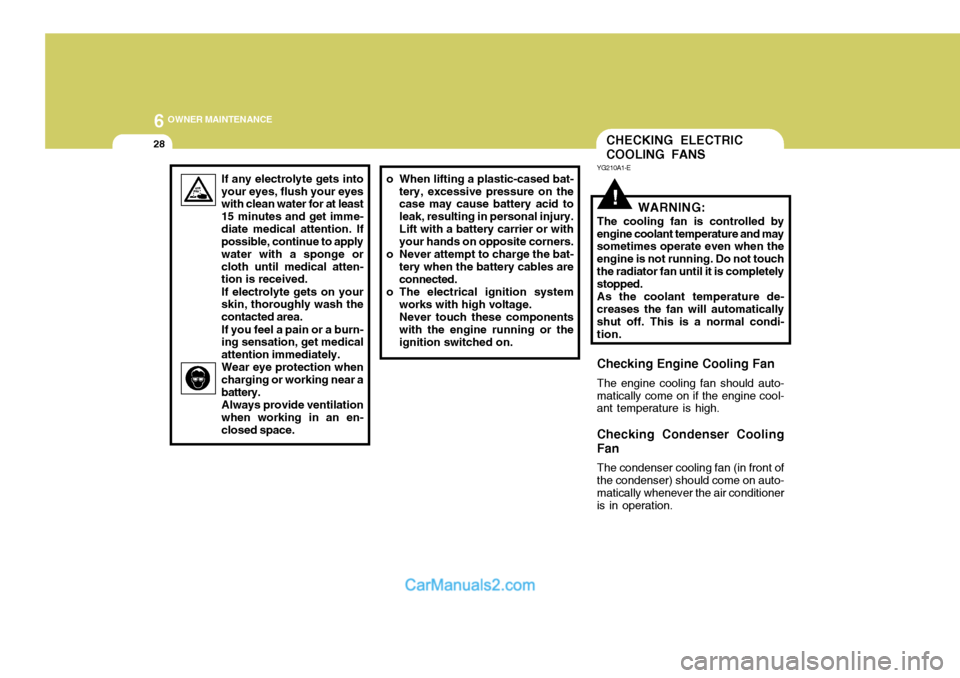
6 OWNER MAINTENANCE
28
!WARNING:
The cooling fan is controlled by engine coolant temperature and may sometimes operate even when the engine is not running. Do not touchthe radiator fan until it is completely stopped. As the coolant temperature de- creases the fan will automatically shut off. This is a normal condi-tion.
Checking Engine Cooling Fan The engine cooling fan should auto-matically come on if the engine cool- ant temperature is high.
Checking Condenser Cooling Fan The condenser cooling fan (in front of the condenser) should come on auto- matically whenever the air conditioner is in operation.
If any electrolyte gets into your eyes, flush your eyes with clean water for at least 15 minutes and get imme-diate medical attention. If possible, continue to apply water with a sponge orcloth until medical atten- tion is received. If electrolyte gets on your skin, thoroughly wash the contacted area. If you feel a pain or a burn- ing sensation, get medical attention immediately.Wear eye protection whencharging or working near abattery.Always provide ventilationwhen working in an en- closed space.o When lifting a plastic-cased bat- tery, excessive pressure on the case may cause battery acid to leak, resulting in personal injury.Lift with a battery carrier or with your hands on opposite corners.
o Never attempt to charge the bat- tery when the battery cables are connected.
o The electrical ignition system works with high voltage. Never touch these components with the engine running or the ignition switched on.
CHECKING ELECTRIC COOLING FANS
YG210A1-E
Page 535 of 539
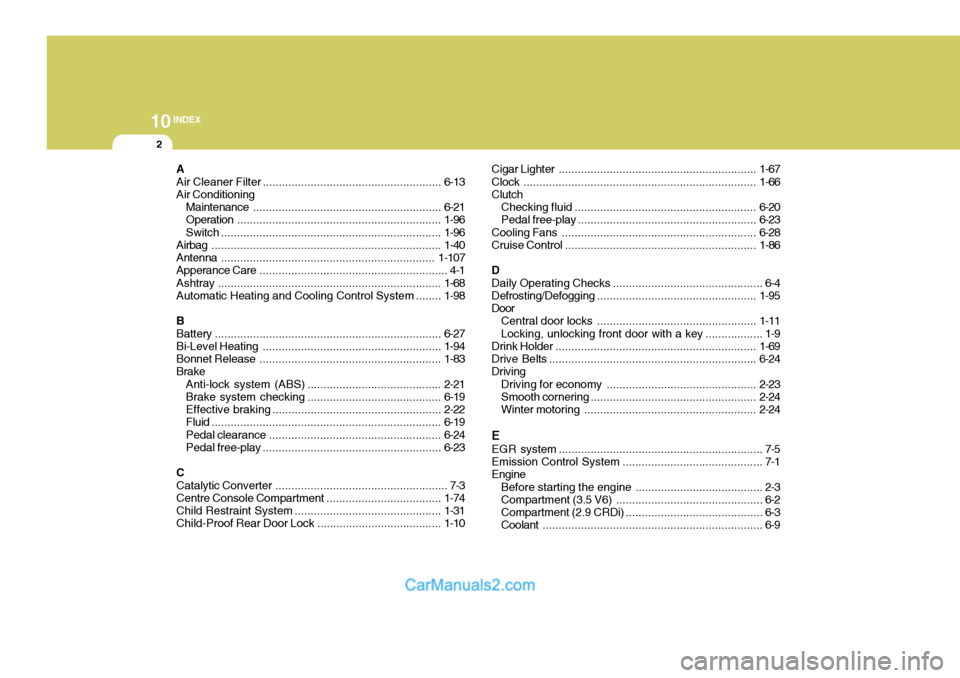
10INDEX
2
A Air Cleaner Filter ........................................................ 6-13
Air Conditioning
Maintenance ........................................................... 6-21
Operation ................................................................ 1-96
Switch ..................................................................... 1-96
Airbag ........................................................................ 1-40
Antenna ................................................................... 1-107
Apperance Care ........................................................... 4-1
Ashtray ...................................................................... 1-68
Automatic Heating and Cooling Control System ........ 1-98
BBattery ....................................................................... 6-27
Bi-Level Heating ........................................................ 1-94
Bonnet Release ......................................................... 1-83
Brake
Anti-lock system (ABS) .......................................... 2-21
Brake system checking .......................................... 6-19
Effective braking ..................................................... 2-22
Fluid ........................................................................ 6-19
Pedal clearance ...................................................... 6-24
Pedal free-play ........................................................ 6-23
CCatalytic Converter ...................................................... 7-3
Centre Console Compartment ....................................1-74
Child Restraint System .............................................. 1-31
Child-Proof Rear Door Lock ....................................... 1-10Cigar Lighter
.............................................................. 1-67
Clock ......................................................................... 1-66
Clutch
Checking fluid ......................................................... 6-20
Pedal free-play ........................................................ 6-23
Cooling Fans ............................................................. 6-28
Cruise Control ............................................................ 1-86
DDaily Operating Checks ............................................... 6-4
Defrosting/Defogging .................................................. 1-95
Door Central door locks .................................................. 1-11
Locking, unlocking front door with a key .................. 1-9
Drink Holder ............................................................... 1-69
Drive Belts ................................................................. 6-24
Driving
Driving for economy ............................................... 2-23
Smooth corneri ng .................................................... 2-24
Winter motoring ...................................................... 2-24
E EGR system ................................................................ 7-5Emission Contro l System ............................................ 7-1
Engine
Before starting the engine ........................................ 2-3 Compartment (3.5 V6) .............................................. 6-2
Compartment (2.9 CRDi) ........................................... 6-3
Coolant ..................................................................... 6-9